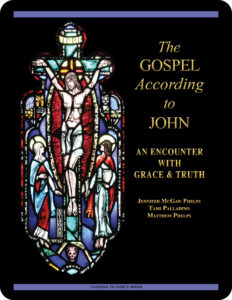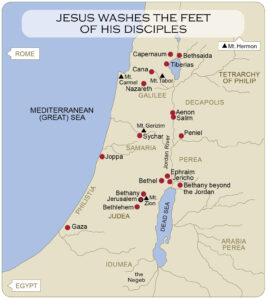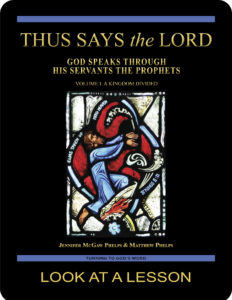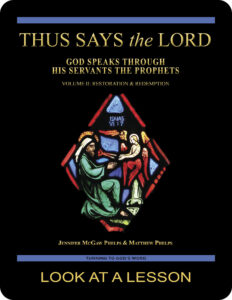 The Gospel According to John:
The Gospel According to John:
An Encounter with Grace & Truth
Lesson 16 A New Commandment I Give to You
the Gospel According to John 13:1–38
Revised Standard Version Catholic Edition (RSVCE)*
New American Bible Revised Edition (NABRE)*
Catechism of the Catholic Church
ex libris (in our library)
glossary for the Gospel According to John
cross references in the Gospel According to John
next lesson: I Am the Way, the Truth & the Life
This material coordinates with Lesson 16 on pages 87–91 in The Gospel According to John: An Encounter with Grace & Truth.
“Now Jesus did many other signs in the presence of the disciples, which are not written in this book; but these are written that you may believe that Jesus is the Christ, the Son of God, and that believing you may have life in his name.”—the Gospel According to John 20:30–31
welcome to our in-depth study of the Gospel According to John
We invite interested groups and individuals to check out the sample first lesson from this 25- lesson Turning to
lesson Turning to  God’s Word Catholic Bible study. These online study pages link to our free lesson videos, as well as to a glossary and cross references in the biblical text. Other study aids include maps, additional commentary, and prayers based on the primary Scripture in each lesson. The Gospel According to John: An Encounter with Grace & Truth has been granted an imprimatur and can be purchased from our website shop. If you have a Bible-study question or comment, click on one of the “ask us your question” or “what do you think” buttons on any online study page.
God’s Word Catholic Bible study. These online study pages link to our free lesson videos, as well as to a glossary and cross references in the biblical text. Other study aids include maps, additional commentary, and prayers based on the primary Scripture in each lesson. The Gospel According to John: An Encounter with Grace & Truth has been granted an imprimatur and can be purchased from our website shop. If you have a Bible-study question or comment, click on one of the “ask us your question” or “what do you think” buttons on any online study page.
open with prayer
It’s always wise to begin any Bible study with prayer, whether reading the Scriptures alone or meeting with others in a discussion study group. You can pray using your own words or use one of the opening prayers on our website. We especially like the following:
Lord Jesus, you promised to send your Holy Spirit
to teach us all things.
As we read and study your word today,
allow it to touch our hearts and change our lives. Amen.
let’s review—the Gospel According to John 12:1–50
In Lesson 15 The Hour Has Come, Jesus and his disciples return to Bethany, where Lazarus’ sister Mary anoints the feet of Jesus. Judas Iscariot opposes this action on the grounds that the expensive ointment could have been sold and the money given to the poor, but Jesus defends Mary’s behavior by saying she’s anointed him for his burial. Many more people begin to follow Jesus after Lazarus is raised from the dead, so the Pharisees decide that Lazarus as well as Jesus should be put to death. Jesus makes a triumphant entry into Jerusalem riding on a donkey. With his hour finally upon him, Jesus begins speaking more openly about his death, and a voice from heaven verifies that the name of God the Father had been glorified and will be glorified again. Jesus goes into hiding.
map notes—is there an earlier parallel to the foot-washing?
The twelfth chapter in the Gospel According to John described Mary of Bethany anointing Jesus’ feet.  In the thirteenth chapter in the Gospel According to John, Jesus washes the disciples’ feet to demonstrate the love they should show each other. In the Gospel According to John 11:2, the Evangelist described Lazarus’ sister as the one “who anointed the Lord with ointment and wiped his feet with her hair.” This suggests the event must have been well-known to be used as an identifier for Mary when introducing her in the Fourth Gospel some time before she actually performed this service for Jesus. Consider how Mary’s anointing of Jesus’ feet might be related to Jesus’ later foot-washing. Click on the image (right) to enlarge the map, which appears on page 89 in The Gospel According to John: An Encounter with Grace & Truth.
In the thirteenth chapter in the Gospel According to John, Jesus washes the disciples’ feet to demonstrate the love they should show each other. In the Gospel According to John 11:2, the Evangelist described Lazarus’ sister as the one “who anointed the Lord with ointment and wiped his feet with her hair.” This suggests the event must have been well-known to be used as an identifier for Mary when introducing her in the Fourth Gospel some time before she actually performed this service for Jesus. Consider how Mary’s anointing of Jesus’ feet might be related to Jesus’ later foot-washing. Click on the image (right) to enlarge the map, which appears on page 89 in The Gospel According to John: An Encounter with Grace & Truth.
 a disconnect with the synoptic Gospels (01:00:08)
a disconnect with the synoptic Gospels (01:00:08)
In the video for this lesson, Turning to God’s Word author Matthew Phelps  points out that the meal Jesus has in the thirteenth chapter in the Gospel According to John isn’t the same as the Last Supper described in the synoptic Gospels According to Matthew, Mark, and Luke. In the Fourth Gospel, Jesus’ teaching about the sacrament of the Eucharist occurs in the sixth chapter, much earlier in his ministry, and it will be taken up again in a surprising way in the account of Jesus’ Crucifixion. The emphasis now is on foot-washing, which appears tied to Jewish cleanliness rituals and
points out that the meal Jesus has in the thirteenth chapter in the Gospel According to John isn’t the same as the Last Supper described in the synoptic Gospels According to Matthew, Mark, and Luke. In the Fourth Gospel, Jesus’ teaching about the sacrament of the Eucharist occurs in the sixth chapter, much earlier in his ministry, and it will be taken up again in a surprising way in the account of Jesus’ Crucifixion. The emphasis now is on foot-washing, which appears tied to Jewish cleanliness rituals and  the sacrament of Baptism. To learn more about Jesus’ actions, read “Disregarding Status” on page 89 in The Gospel According to John: An Encounter with Grace & Truth.
the sacrament of Baptism. To learn more about Jesus’ actions, read “Disregarding Status” on page 89 in The Gospel According to John: An Encounter with Grace & Truth.
The Scripture ranges for the videos that accompany this Catholic Bible study match the Scripture ranges for the sets of questions in The Gospel According to John: An Encounter with Grace & Truth. You can follow along as Turning to God’s Word author Matthew Phelps discusses Lesson 16, “A New Commandment I Give to You,” on pages 87–91 in the study book.
Judas must have been keeping a low profile
There are a number of interesting things in this section in the Gospel According to John, but one of the most intriguing is the reaction of Jesus’ disciples when Jesus announces that one of them is about to betray him. Here most commentators focus on Judas’ character, although a few look at Peter and John, and some try to sense what Jesus was feeling. But in the Gospel According to John 13:22, the Evangelist tells us: “The disciples looked at one another, uncertain of whom he spoke.”
We know from this sentence that Judas was keeping a low profile. He wasn’t running around talking to the other disciples about what he was thinking about doing. Because Judas was keeping his thoughts to himself, we don’t have much information to guide us in determining just why it was that Judas decided to betray Jesus. The Evangelist suggests that Judas was known to be a thief, so he may have been motivated by his desire for money.
how can the other disciples be unaware of Judas’ intentions?
We also know that the other disciples have no idea about the identity of Jesus’ betrayer. They can’t even harbor a guess. This seems rather unusual in a close-knit group of men who have been living and traveling together for some time. We would expect them to have formed some alliances and to have been talking some about each other to each other. We would expect them to have a clue about Judas, yet Peter asks John to ask Jesus outright to identify the betrayer. Jesus does share this information with John, the disciple whom Jesus loved.
This passage suggests that although the disciples not only don’t know each other very well, they may not know themselves well either. Perhaps they fail at observing each other because they aren’t used to examining their own behaviors and motivations. The question of who’s going to betray Jesus is important, but even more important is the question of why. The disciples are incapable of figuring out which one of them has a motive for betrayal. In a section of the Gospel According to John in which Jesus emphasizes the importance of love, it seems apparent that the disciples need to hear this teaching.
WHAT DO YOU THINK about the devil?
In the Gospel According to John 6:70, Jesus told his disciples that one of them was a devil.
? Which disciple does the Evangelist identify as a devil in the sixth chapter in the Gospel  According to John?
According to John?
? What does the word devil mean? If necessary, refer to the vocabulary box on page 48 in The Gospel According to John: An Encounter with Grace & Truth.
? In the thirteenth chapter in the Gospel According to John, how does the Evangelist describe the way in which the devil influences Judas Iscariot to betray Jesus?
? What might be the false accusation is that Judas intends to make when he betrays Jesus?
? In the Gospel According to John 13:27, the Evangelist switched from talk of the devil to write that Satan entered Judas. What additional information might the Evangelist be implying about why Jesus is betrayed? If necessary, refer to the vocabulary box on page 91 in The Gospel According to John: An Encounter with Grace & Truth.
 First Letter of John—you could look it up in our archives
First Letter of John—you could look it up in our archives
More than 2,000 years after Jesus gave his new commandment, it remains at the heart of Christianity. To learn the significance of how perfect love is described in the First Letter of John, read Lost in Translation, an online column in which Turning to God’s Word author Matthew Phelps helps readers connect with ideas expressed in the original languages of the Scriptures. New Lost in Translation entries are posted on Mondays, and past entries are archived on our website. Contact us if you’d like to receive Lost in Translation by email every week.
a religious law unlike any other
Jesus’ commandment that his followers love one another is a radical departure from the law that the Jews are used to following, although it forms the basis of the Ten Commandments. The commandments list requirements of ways we can show our love for God as well as limitations on how we’re to treat our neighbors. We have to honor our parents. We can’t kill our neighbor. We can’t commit adultery. We can’t steal from our neighbor. We can’t bear false witness against our neighbor. We can’t covet our neighbor’s wife or servants, and we can’t covet any of his material possessions. The Ten Commandments represent the bare minimum of good behavior that is required of God’s people.
A more advanced law of love shows up in Jesus’ teaching in the Gospel According to Matthew 7:12, in what’s come to be known as the “golden rule”: “So whatever you wish that men would do to you, do so to them; for this is the law and the prophets.” Although the “golden rule” frequently is considered a New Testament development, it’s actually based—as Jesus teaches—on the law and the prophets, and it appears in the book of Leviticus 19:18: “You shall not take vengeance or bear any grudge against the sons of your own people, but you shall love your neighbor as yourself.” While the “golden rule” moves from a set of rules to one, it’s motivational focus remains far less altruistic than Jesus’ new commandment.
the popes inspire us—model of love
Jesus’ new commandment in the Gospel According to John 13:34 is truly something new. Instead of asking his followers to keep the minimum requirements of the Ten Commandments, or even to treat others the way we would like to be treated, Jesus takes things to a much higher level when he asks that we love others the same way that he loves us. There’s no wiggle-room, and this isn’t a suggestion or some obscure idea that Jesus is tossing out for discussion. It’s a commandment. We are commanded to love each other, even if we don’t much feel like it. And we aren’t to impose limitations on our love. This is love that goes well beyond the Ten Commandments, and beyond loving your neighbor as yourself. This is a commandment to love our neighbor the way God loves us. Pope Benedict XVI reflects on this in the papal quote on page 88 in The Gospel According to John: An Encounter with Grace & Truth.
Commandments, or even to treat others the way we would like to be treated, Jesus takes things to a much higher level when he asks that we love others the same way that he loves us. There’s no wiggle-room, and this isn’t a suggestion or some obscure idea that Jesus is tossing out for discussion. It’s a commandment. We are commanded to love each other, even if we don’t much feel like it. And we aren’t to impose limitations on our love. This is love that goes well beyond the Ten Commandments, and beyond loving your neighbor as yourself. This is a commandment to love our neighbor the way God loves us. Pope Benedict XVI reflects on this in the papal quote on page 88 in The Gospel According to John: An Encounter with Grace & Truth.
for additional reflection
In the Gospel According to John 13:34, Jesus changes the moral standard operative in the Old Testament to something human beings never could arrive at by reason alone. The following questions are designed to help readers begin to form their own thoughts and ideas related to the Gospel According to John 13:1–38. For more reflection questions, refer to the introduction to Lesson 16 on page 87 in The Gospel According to John: An Encounter with Grace & Truth.
 ? What is Jesus’ new commandment?
? What is Jesus’ new commandment?
? How is it built on the Ten Commandments found in the twentieth chapter in the book of Exodus?
? Consider how Jesus’ new commandment is based on what he plans to do for all of humanity.
? In the Gospel According to John 13:35, Jesus tells his followers that they’ll be able to be recognized as his disciples if they have love for one another. Why does love come to be seen as the sure way of identifying a Christian?
? Consider whether you can be identified as a Christian based on how much you love other people.
the best Catholic commentary about Scripture
To find out more about how Church teaching is supported by Scripture passages in The Gospel According to John: An Encounter with Grace & Truth, check out the Index of Citations in the Catechism of the Catholic Church. Links (Revised Standard Version Catholic Edition [RSVCE*]) to the primary Scripture passages in the lesson and relevant paragraphs in the Catechism are provided here. Not every passage in the biblical text for this study is referenced in a Catechism paragraph, however.
the Gospel According to John 13:1—paragraphs 557, 609, 616, 622, 730, 1085, 1380, 1524, 1823, 2843
the Gospel According to John 13:1–17—paragraph 1337
the Gospel According to John 13:3—paragraph 423
the Gospel According to John 13:12–15—paragraph 1269
the Gospel According to John 13:12–16—paragraph 1694
the Gospel According to John 13:13—paragraph 447
the Gospel According to John 13:15—paragraph 520
the Gospel According to John 13:20—paragraph 858
the Gospel According to John 13:24—paragraphs 782, 1823, 1970, 2195, 2822, 2842
ways our glossary might prove helpful
In addition to providing extra information about geographical locations, our glossary also points out  persons and places mentioned in the biblical text under multiple names or spellings. If you can remember a name but aren’t sure in which lesson it shows up, you can find it in the glossary, which lists every proper noun that appears in the primary biblical text for The Gospel According to John: An Encounter with Grace & Truth.
persons and places mentioned in the biblical text under multiple names or spellings. If you can remember a name but aren’t sure in which lesson it shows up, you can find it in the glossary, which lists every proper noun that appears in the primary biblical text for The Gospel According to John: An Encounter with Grace & Truth.
to learn more, read more Scripture
If you’re having difficulty with a passage of Scripture, it can be helpful to read the relevant  cross references—but looking these up can take time. To make that easier, we’ve compiled the cross references from the Revised Standard Version Second Catholic Edition (RSV2CE)—the translation that we reprint in our study books. That list can be found at the top of every online study page accompanying this study, and it includes links to each of the cross references in the primary biblical text for The Gospel According to John: An Encounter with Grace & Truth.
cross references—but looking these up can take time. To make that easier, we’ve compiled the cross references from the Revised Standard Version Second Catholic Edition (RSV2CE)—the translation that we reprint in our study books. That list can be found at the top of every online study page accompanying this study, and it includes links to each of the cross references in the primary biblical text for The Gospel According to John: An Encounter with Grace & Truth.
don’t forget about our indexes & extra online material

 If you’re trying to locate information about a specific Scripture passage, you can look it up in the index at the back of the study book or sample lesson. If you want to find a particular commentary, you can look up its title in the topics index. To learn more about another book of the Bible for which there’s a Turning to God’s Word study, visit the online study directories to read the commentaries and watch any accompanying videos. Finally, if you have a question or would like to make a comment about any of our studies, you can use one of the “ask us your question” or “what do you think” buttons to email our authors.
If you’re trying to locate information about a specific Scripture passage, you can look it up in the index at the back of the study book or sample lesson. If you want to find a particular commentary, you can look up its title in the topics index. To learn more about another book of the Bible for which there’s a Turning to God’s Word study, visit the online study directories to read the commentaries and watch any accompanying videos. Finally, if you have a question or would like to make a comment about any of our studies, you can use one of the “ask us your question” or “what do you think” buttons to email our authors.
ex libris—Church documents & books about religious topics
You can find links to magisterial documents referred to in Turning to God’s Word Catholic Bible studies  at ex libris—magisterial documents. This page includes a listing of significant recent encyclicals as well as a number of historical Church documents. Recommended books related to Scripture study can be found at ex libris—main bookshelf.
at ex libris—magisterial documents. This page includes a listing of significant recent encyclicals as well as a number of historical Church documents. Recommended books related to Scripture study can be found at ex libris—main bookshelf.
wondering how to pronounce some of these words?
The following link is to a reading from the New International Version (NIV) Bible. To listen, click on the audio icon above the printed text. Although not taken from the translations used in our study materials, the NIV reading provides an audio guide to pronunciation of words in this lesson’s primary biblical text. A close online version of the translation of the Bible used in Catholic liturgy in the United States as well as an audio guide for daily Mass readings for the current month can be found on the website of the United States Conference of Catholic Bishops (USCCB).
the Gospel According to John 13:1–38 (NIV)
close with Bible-based prayer related to this lesson
Many of our Catholic study groups like to conclude their discussions with a prayer based on the scriptural focus of their lesson, and some participants include Scripture-specific prayer in their individual study. If you’re uncomfortable composing your own Bible-based prayers, you can follow our four easy steps, or you can use the following prayer based on this lesson’s text from the Gospel According to John.
God our Father, you sent your Son
to model the way to love.
Help us to follow his example and give us the grace
to love everyone you’ve placed in our lives.
We ask this in the name of Jesus Christ. Amen.
Lesson 17 I Am the Way, the Truth & the Life—the Gospel According to John 14:1–31
Lesson 15 The Hour Has Come—the Gospel According to John 12:1–50
you also may like our two-part study of the prophets

 Thus Says the LORD: God Speaks Through His Servants the Prophets—Volume I: A Kingdom Divided examines the prophets in their historical context using the First and Second Books of the Kings and other Old Testament passages written before the Babylonian Exile in 586 B.C. Volume II: Restoration & Redemption looks at the post-exilic prophets. This 51-lesson Catholic Bible study builds on The United Kingdom of Israel: Saul, David & Solomon Foreshadow Christ the King. Click on the books’ covers to view a sample lesson from each volume.
Thus Says the LORD: God Speaks Through His Servants the Prophets—Volume I: A Kingdom Divided examines the prophets in their historical context using the First and Second Books of the Kings and other Old Testament passages written before the Babylonian Exile in 586 B.C. Volume II: Restoration & Redemption looks at the post-exilic prophets. This 51-lesson Catholic Bible study builds on The United Kingdom of Israel: Saul, David & Solomon Foreshadow Christ the King. Click on the books’ covers to view a sample lesson from each volume.
start a Turning to God’s Word Bible study
 Thank you for your interest in The Gospel According to John: An Encounter with Grace & Truth.
Thank you for your interest in The Gospel According to John: An Encounter with Grace & Truth.  Information about beginning a Turning to God’s Word Bible study can be found at start a Bible study. Tami, Matthew, and I are available to answer questions and offer support. Contact us if you’d like to start one of our studies or have your schedule listed with other TtGW study groups on our website. —Jennifer
Information about beginning a Turning to God’s Word Bible study can be found at start a Bible study. Tami, Matthew, and I are available to answer questions and offer support. Contact us if you’d like to start one of our studies or have your schedule listed with other TtGW study groups on our website. —Jennifer
*There are seven deuterocanonical books in the Old Testament—the Books of Tobit, Judith, Wisdom, Sirach, Baruch, and First and Second Maccabees, as well as some passages in the Books of Esther and Daniel. Protestants usually refer to these works as “apocryphal,” a word that means “outside the (Protestant) canon” because they’re excluded from most Protestant Bibles. The word “deuterocanonical” means “second canon”; Catholics use that word to refer to any section of the Catholic Old Testament for which there are no extant, or existing, Hebrew manuscripts. All of the deuterocanonical books appear in the Septuagint, the earliest remaining versions of which date to the 1st century B.C. This Greek translation of the Old Testament was in common use by Jews at the time of Jesus—but the same books aren’t found in existing Hebrew manuscripts, which aren’t as old as the oldest version of the Septuagint. Learn more by reading How Do Catholic & Protestant Bibles Differ?
Turning to God’s Word printed Bible studies use the 2006 Revised Standard Version Second Catholic Edition (RSV2CE) translation for all Scripture references except those to the Psalms, which are taken from The Abbey Psalms and Canticles, prepared by the Benedictine monks of Conception Abbey and published in 2020 by the United States Conference of Catholic Bishops (USCCB). All Scripture links for the online study pages for The Gospel According to John: An Encounter with Grace & Truth are to the 1966 Revised Standard Version Catholic Edition (RSVCE) translation. The New International Version (NIV) audio recordings follow the same chapter and verse numbering as the RSV Catholic translations, but the NIV translation doesn’t include the deuterocanonical books and passages.
The 1966 RSVCE uses archaic pronouns and verb forms such as “thee,” “thou,” “didst” in the Psalms and in direct quotations attributed to God. The 2006 RSV2CE replaces those with more accessible English. The few significant translation changes in the RSV2CE include rendering almah as “virgin” in the Book of Isaiah 7:14 and restoring the term “begotten” in the Gospel According to John 3:16.
Numbering varies for some passages in this Bible study. Turning to God’s Word studies (print and digital) follow the numbering in the Revised Standard Version Catholic translations (RSV2CE and RSVCE). Discrepancies in the New American Bible Revised Edition (NABRE) are noted in the Index of Scripture Citations in the study book and the online sample.
 You can learn more about the Psalms by viewing a sample lesson from the Turning to God’s Word Catholic Bible study Sing a New Psalm: Communicating with God Through the Prayers of the Church—Volume I: Lauds & Vespers. The second part of that study, Sing a New Psalm: Communicating with God Through the Prayers of the Church—Volume II: Vigils, Day Prayer & Compline, is scheduled for publication in 2025. Some verse numbers may vary in different translations of the Psalms.
You can learn more about the Psalms by viewing a sample lesson from the Turning to God’s Word Catholic Bible study Sing a New Psalm: Communicating with God Through the Prayers of the Church—Volume I: Lauds & Vespers. The second part of that study, Sing a New Psalm: Communicating with God Through the Prayers of the Church—Volume II: Vigils, Day Prayer & Compline, is scheduled for publication in 2025. Some verse numbers may vary in different translations of the Psalms.
